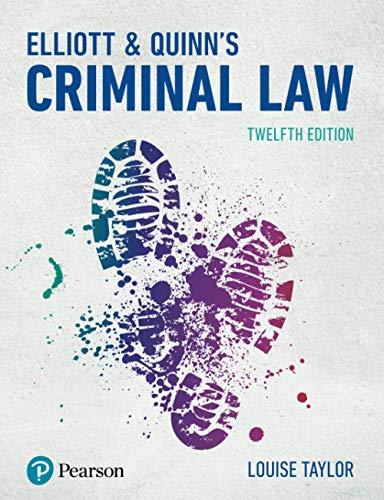Question
The answers have to be from this paragraph: Introduction to Law, Ethics, and Legal Reasoning Introduction to Law, Ethics, and Legal Reasoning A Chapter 1
The answers have to be from this paragraph: Introduction to Law, Ethics, and Legal Reasoning Introduction to Law, Ethics, and Legal Reasoning A Chapter 1 covers an introduction to some legal concepts and issues that you will need to understand for the remainder of this class. A lot of the concepts will be necessary as we move forward in the course. Make sure you understand the following things: 1. Sources of American Law - you should be able to state and explain what each of the sources of American Law are. The sources of American law are the places we look to see what the law is. It includes the statutes or regulations that judges review in determining how a case will be decided. It also includes the information that is provided to jurors to assist them in deciding cases (Criminal and Civil). 2. The common law tradition and the importance of the doctrine of Stare Decisis (pronounced Stare-aye Decise-is). Today, the doctrine of stare decisis remains a big part of our judiciary. The court of appeals and supreme court regularly are deciding cases that the courts throughout the state of lowa are required to follow. You should understand the difference between courts of equity (courts of fairness) and courts of law (to recover payment of money or damages or property). You should understand the difference between the different schools of legal thought. 3. Understand the difference between criminal law and civil law. Criminal law is intended to protect society where civil law is to protect individuals rights by allowing them to sue each other. Criminal cases are initiated by a governmental agency such as The State of lowa. Civil actions are brought by the individual. In a criminal case, the victim of the offense has no power over whether charges are initiated, whether a plea deal is reached or whether the case is dismissed. The role of the victim in a criminal case is to be a witness in the case if necessary. In a case, the injured party is the one who actually initiates the civil lawsuit and has total control over whether the case is settled or goes to trial. 4. Law vs. Ethics. It may seem to be common sense that if something is illegal that it is unethical, but because of the difference in moral principles from one individual to another, this may not be as black and white as it seems. There are also actions that are legal that may be considered to be unethical. Take some time to review this material and think about the difference between those two concepts and how they can conflict.

Step by Step Solution
There are 3 Steps involved in it
Step: 1

Get Instant Access to Expert-Tailored Solutions
See step-by-step solutions with expert insights and AI powered tools for academic success
Step: 2

Step: 3

Ace Your Homework with AI
Get the answers you need in no time with our AI-driven, step-by-step assistance
Get Started


